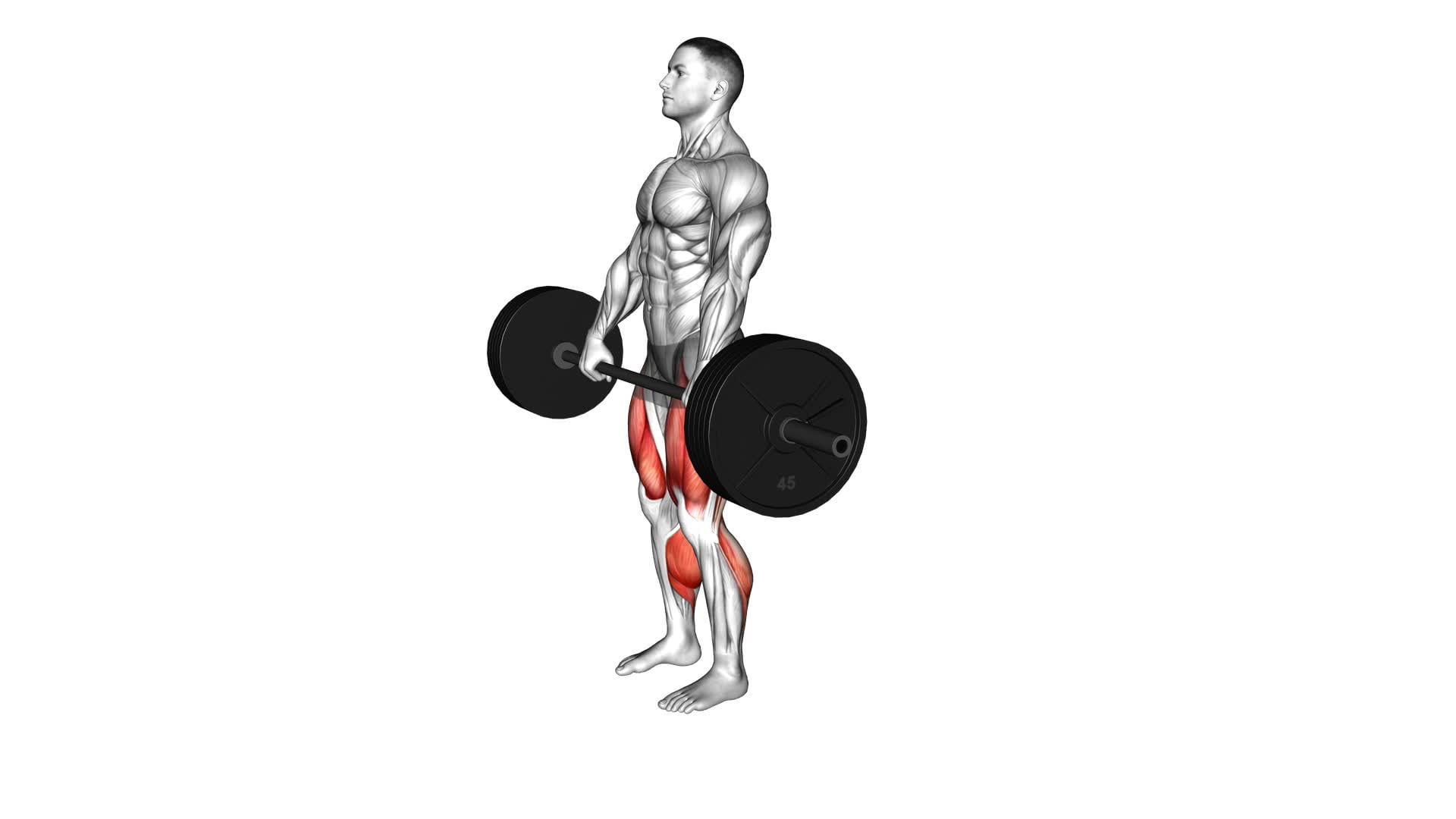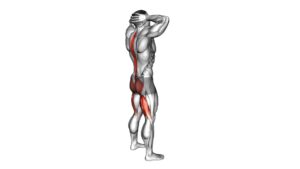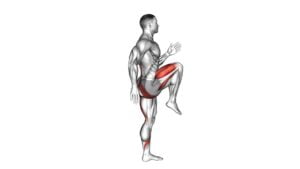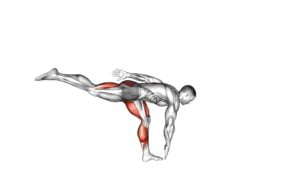Axle Deadlift (male) – Video Exercise Guide & Tips

Are you looking to strengthen your lower body and build a powerful core? The Axle Deadlift is a perfect exercise for you!
Watch This Exercise Video
In this video exercise guide, we'll show you the proper setup and grip technique, target muscles, and how to avoid common mistakes.
Plus, we'll give you tips on how to progress and increase your weight safely.
Get ready to take your strength training to the next level with the Axle Deadlift!
Key Takeaways
- The axle deadlift targets multiple muscle groups simultaneously.
- Proper setup and grip technique are important for maximizing the benefits of the exercise.
- The axle deadlift can help improve grip strength and the ability to hold heavy weights.
- It is essential to avoid common mistakes and focus on progression and safety tips for optimal results.
Benefits of the Axle Deadlift
One of the main benefits of the Axle Deadlift is that it targets multiple muscle groups simultaneously, allowing you to get a more efficient and effective workout. This exercise is particularly effective in improving grip strength, which is essential for various activities and sports. By gripping the thick axle, you engage your hands, forearms, and fingers more intensely than with a regular barbell, challenging your grip to work harder. This not only enhances your ability to hold onto heavy weights but also transfers to other exercises like pull-ups and rows.
Another advantage of the Axle Deadlift is the variations it offers compared to the traditional deadlift. With a regular barbell, your hands are limited to a specific grip width, which can sometimes put strain on your wrists or shoulders. However, the axle allows for various grips, such as overhand, mixed, or even using straps. This versatility helps you adjust the exercise to your body's needs and preferences, reducing the risk of injury and discomfort.
Proper Setup and Grip Technique
To properly set up and execute the Axle Deadlift, you need to focus on your grip technique and ensure a secure hold on the thick axle. Here are some proper form cues, variations, and modifications to help you get the most out of this exercise:
- Grip Technique:
- Start with an overhand grip, placing your hands shoulder-width apart on the axle.
- Squeeze the bar tightly to engage your forearm muscles and maintain a secure hold.
- Avoid using straps or mixed grip variations to challenge your grip strength further.
- Proper Form Cues:
- Stand with your feet shoulder-width apart, toes slightly turned out.
- Hinge at the hips and bend your knees to lower into the starting position, keeping your back straight and chest lifted.
- Engage your core and maintain a neutral spine throughout the movement.
- Drive through your heels and extend your hips and knees to lift the axle off the ground, keeping it close to your body.
- Variations and Modifications:
- If the thick axle is too challenging, start with a regular barbell or dumbbells to build up your grip strength.
- You can also perform the Axle Deadlift from blocks or elevated surfaces to increase the range of motion and target different muscle groups.
Remember to always prioritize proper form and gradually increase the weight as you progress.
Key Muscles Targeted During the Exercise
The Axle Deadlift primarily targets the muscles in your lower body and back. This exercise is a compound movement that engages multiple muscle groups simultaneously, making it an efficient and effective exercise for building strength and muscle mass.
The key muscles targeted during the Axle Deadlift include the glutes, hamstrings, quadriceps, erector spinae muscles, and the trapezius muscles.
During the Axle Deadlift, the glutes and hamstrings play a significant role in generating the force needed to lift the weight off the ground. These muscles are responsible for hip extension, which is the primary movement involved in the exercise. The quadriceps muscles, located at the front of your thighs, also contribute to the movement by providing stability and assisting in knee extension.
The erector spinae muscles, which run along the length of your spine, are heavily activated during the Axle Deadlift. These muscles help to maintain an upright posture and prevent your back from rounding as you lift the weight. Additionally, the trapezius muscles, located in your upper back and neck, assist in stabilizing the shoulder blades and maintaining proper form throughout the exercise.
Common Mistakes to Avoid
To avoid common mistakes during the Axle Deadlift, ensure that you maintain proper form and engage the key muscles throughout the exercise. Here are some common mistakes to watch out for and tips to correct them:
- Rounding your back: One of the most common mistakes is rounding your back during the lift. This can put excessive stress on your spine and increase the risk of injury. To prevent this, focus on keeping your back straight and your chest up throughout the movement. Engage your core muscles to maintain a stable spine.
- Lifting with your arms: Another common mistake is relying too much on your arms to lift the weight. Remember, the deadlift is primarily a lower body exercise that targets your hamstrings, glutes, and lower back. To correct this, focus on driving through your heels and using your legs and hips to lift the weight. Keep your arms relaxed and let them act as hooks to hold the bar.
- Not fully extending your hips: Many people fail to fully extend their hips at the top of the lift, which reduces the effectiveness of the exercise. To fix this, make sure you drive your hips forward and squeeze your glutes at the top of the movement. This will ensure that you're fully engaging your posterior chain and getting the most out of the exercise.
How to Progress and Increase Your Weight
To progress and increase your weight in the Axle Deadlift, you can follow these steps.
First, focus on proper form and technique. This is essential for preventing injuries and maximizing your gains. Make sure to keep your back straight, engage your core, and lift with your legs.
Next, gradually increase the weight you lift. Start with a weight that you can comfortably lift for 8-10 reps, and then slowly increase the weight by 5-10 pounds each week. This progressive overload will challenge your muscles and stimulate growth.
Additionally, incorporate progression techniques such as drop sets, where you perform a set with a heavy weight and then immediately decrease the weight to continue the set. This helps to push your muscles to the limit and promote strength gains.
Another effective technique is incorporating pauses into your lifts. By pausing at the top or bottom of the lift, you increase time under tension, which can lead to greater muscle development.
Lastly, don't forget to fuel your body properly with a balanced diet and adequate rest. This will support muscle growth and recovery.
Follow these weightlifting tips and you'll be on your way to increasing your weight in the Axle Deadlift.
Safety Tips for Performing the Axle Deadlift
To perform the axle deadlift safely, it's crucial to maintain proper form techniques. This includes keeping your back straight, engaging your core, and using a shoulder-width grip.
Additionally, it's important to take preventative measures to avoid back injuries by warming up properly, using proper lifting techniques, and gradually increasing the weight.
Lastly, make sure to have the necessary equipment and accessories, such as an axle bar and weight plates, to ensure a safe and effective workout.
Proper Form Techniques
Maintain proper alignment and stability throughout the movement to ensure safety and maximize the benefits of the Axle Deadlift.
To improve your technique and avoid common errors, follow these tips:
- Set up correctly: Stand with your feet hip-width apart, toes pointing forward, and grip the axle with an overhand grip outside your knees. Keep your back straight and your shoulders pulled back.
- Engage your core: Before lifting, brace your core by tightening your abdominal muscles. This will help stabilize your spine and protect your lower back.
- Lift with your legs: As you begin the lift, push through your heels and drive your hips forward. Keep your back straight and avoid rounding your shoulders.
Preventing Back Injuries
To prevent back injuries while performing the Axle Deadlift, focus on maintaining proper form and technique throughout the exercise. Back injury prevention is crucial when performing this exercise, as it places a significant amount of stress on the posterior chain, which includes your lower back muscles, glutes, and hamstrings.
Strengthening the posterior chain is essential to support your spine and prevent injury. Start by engaging your core and keeping your back straight throughout the movement. Avoid rounding your back or lifting with your back instead of your legs.
Keep your shoulders back and down, and hinge at your hips as you lower the weight. Remember to lift with your legs and not with your back to maintain a safe and effective Axle Deadlift.
Equipment and Accessories Needed
You will need specific equipment and accessories to safely perform the Axle Deadlift. Here is a list of the essential items you'll need:
- Axle bar: This is the main piece of equipment for the Axle Deadlift. It's a thick bar that challenges your grip strength and engages more muscles compared to a regular barbell.
- Weight plates: You'll need weight plates to load the axle bar. Make sure to choose plates that are compatible with the axle bar's diameter.
- Lifting straps: While not necessary, lifting straps can provide extra support and help you maintain a secure grip on the bar. They can be especially useful if you have weak grip strength.
Recommended accessories for the Axle Deadlift include chalk to improve grip, lifting belts for added support, and wrist wraps for added stability.
Remember to always prioritize safety and use proper technique when performing the Axle Deadlift.
Frequently Asked Questions
How Does the Axle Deadlift Differ From a Traditional Barbell Deadlift?
The axle deadlift differs from a traditional barbell deadlift in a few key ways.
Firstly, the axle bar used in the axle deadlift has a thicker diameter, which challenges your grip strength more than a standard barbell.
Additionally, the wider grip required in the axle deadlift places more emphasis on your back and traps.
The benefits of the axle deadlift include increased grip strength, improved back and trap development, and a more functional movement pattern.
Can the Axle Deadlift Help Improve Grip Strength?
The axle deadlift is a great exercise for improving grip strength. By lifting the thicker axle bar, you'll have to work harder to hold onto it, which builds strength in your hands and forearms.
This exercise has numerous benefits, including increased grip strength for everyday tasks and sports activities. It also helps to prevent injuries by strengthening your grip.
Incorporating the axle deadlift into your routine can lead to noticeable improvements in your grip strength over time.
Is the Axle Deadlift Suitable for Beginners or Is It More Advanced?
The axle deadlift can be suitable for beginners with some modifications. It's important to start with lighter weights and focus on proper form to avoid injury. As you progress, you can gradually increase the weight.
Incorporating the axle deadlift in your workout routine can have many benefits. It helps strengthen your grip, works your lower body muscles, and improves overall strength and power.
Just remember to start slow and listen to your body.
Are There Any Alternative Exercises That Target Similar Muscles as the Axle Deadlift?
If you're looking for alternative exercises that target similar muscles as the axle deadlift, there are a few options you can try.
One option is the conventional deadlift, which also works the muscles in your lower back, glutes, and hamstrings.
Another option is the Romanian deadlift, which focuses more on the hamstrings and glutes.
Lastly, the sumo deadlift can also be a good alternative, as it places more emphasis on the inner thighs and quads.
What Are Some Common Modifications or Variations of the Axle Deadlift?
When it comes to the axle deadlift, there are a few common modifications and variations you can try.
One option is to change up your grip by using a mixed grip or a hook grip.
Another modification is to incorporate pauses at different points in the lift to increase the difficulty.
Using an axle bar for deadlifts also has its benefits, such as increasing grip strength and targeting the muscles in your forearms and upper back.
Conclusion
In conclusion, the axle deadlift is a highly effective exercise for targeting the muscles in your lower body, core, and back. By following the proper setup and grip technique, you can maximize the benefits and avoid common mistakes.
As you progress, gradually increase the weight to challenge yourself and continue building strength. Remember to prioritize safety by maintaining proper form and listening to your body's limits.
Incorporate the axle deadlift into your workout routine for improved strength and functional fitness.

Author
Years ago, the spark of my life’s passion ignited in my mind the moment I stepped into the local gym for the first time. The inaugural bead of perspiration, the initial endeavor, the very first surge of endorphins, and a sense of pride that washed over me post-workout marked the beginning of my deep-seated interest in strength sports, fitness, and sports nutrition. This very curiosity blossomed rapidly into a profound fascination, propelling me to earn a Master’s degree in Physical Education from the Academy of Physical Education in Krakow, followed by a Sports Manager diploma from the Jagiellonian University. My journey of growth led me to gain more specialized qualifications, such as being a certified personal trainer with a focus on sports dietetics, a lifeguard, and an instructor for wellness and corrective gymnastics. Theoretical knowledge paired seamlessly with practical experience, reinforcing my belief that the transformation of individuals under my guidance was also a reflection of my personal growth. This belief holds true even today. Each day, I strive to push the boundaries and explore new realms. These realms gently elevate me to greater heights. The unique combination of passion for my field and the continuous quest for growth fuels my drive to break new ground.







